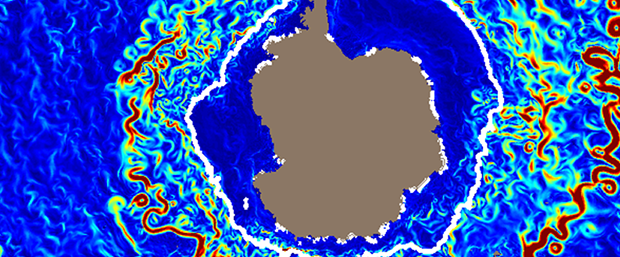SCIENCE
Ice, Ice, Baby
University of Washington researchers use Kraken to unravel mysterious Antarctic sea ice
The Southern hemisphere has a number of eccentricities familiar to those of us from North of the equator: Penguins instead of polar bears, toilets that supposedly flush backwards, and a night sky that features a different cast of stars. The poles are no exception.

Unlike the Arctic, which is notoriously shedding more and more ice every year, the Antarctic sea ice—literally frozen, floating ocean water—is actually increasing in extent. And while scientists aren’t exactly sure why, they do have a few main suspects. The current culprit of choice is the hole in the ozone layer that hovers over the Antarctic continent, creating a number of natural phenomena, not the least of which is increased wind circulation, creating a lower surface temperature on the Antarctic continent and altering ocean heat transport.
Not so fast says Cecilia Bitz of the University of Washington and the principal investigator of the most detailed simulations to date of Antarctic sea ice. She too was a believer in the ozone hypothesis, until her team, a branch of the National Science Foundation’s PetaApps program, ran 10-km simulations of the Antarctic sea ice using the Community Earth Systems Model (CESM) to determine if, as expected, the depletion of ozone at the bottom of our planet is indeed causing the sea ice to expand.
(CESM) is a fully-coupled, global climate model that provides state-of-the-art simulations of the Earth's past, present, and future climate states. It is among the most sophisticated climate models available, a global model that provides consistent simulation of high-resolution effects. However, even it has its problems, as previous models of the Antarctic sea ice showed an actual decrease in area annually, in direct contrast with observations, which show an overall expansion.
Bitz’s hypothesis was that the models were too coarse, and by ramping up the resolution ten-fold her team could get to the truth. For example, other factors such as ocean eddies could likewise play a major role, but they have been largely parameterized, or approximated, to vary with wind strength. Bitz believed that the model’s ocean response to increased wind strength at coarse resolution was incorrect, downplaying environmental factors such as ocean currents and eddies that could likewise contribute to the overall expansion of the sea ice.
After months of preparation, Bitz’s team began the two-month-long process of the actual simulations, with most of the runs consuming 6,000 of the University of Tennessee’s Kraken supercomputer’s more than 112,000 cores, consuming more than 11 million CPU hours with each simulation generating approximately 50 terabytes of data. “Just to analyze and interpret that amount of data is intensive,” said Bitz, who is also using the University of Tennessee’s Nautilus supercomputer in the effort and TeraGrid systems at the Texas Advanced Computing Center to teach a climate modeling course and study geoengineering as a means to offset our increase in carbon dioxide production (Nature 468, 955–958 (16 December 2010)).

Figure 1: Current speeds (in cm/s) and sea ice extent (15% concentration contour) are shown for a randomly chosen October in the high and low resolution runs for preindustrial ozone levels. Depleting ozone increases the westerly wind stress, and therefore strengthens the ocean currents. This research addresses whether the parameterized eddy response at low resolution (left panel) correctly reproduces the resolved eddy response at high resolution (right panel).

Figure 2: Surface temperature (in degrees Celsius) response to depleting ozone over the second half of the 20th century. The response at low resolution (left panel) is about twice as strong as at high resolution (right panel).
Unfortunately, the teams analyses of the Antarctic sea ice simulations aren’t exactly what was expected, but it does seem that they are getting closer to nature. “A lot of the subtle behavior is different at fine resolution,” said Bitz. For example, the finer scale model shows some areas of Antarctic sea ice expanding that match observation, but other areas that should be expanding aren’t. Bitz believes that this may not be due to flaws in the model, but longer-term climate variability that isn’t influenced by human activity, such as the Little Ice Age.
However, one thing is clear: the model reveals that the expansion is very likely not solely due to ozone, a bit of a breakthrough. While the team’s simulations didn’t put an end to speculation regarding the expansion of the Antarctic sea ice, they were an absolute milestone in climate modeling. Bitz is extremely grateful to the NSF’s PetaApps program. “I could only do what I did with the help of that group,” she said, adding that NICS and Kraken, its superstar system, “have both been very helpful to me . . . the machine is very well managed and stable.”
Next, she said, her team will turn their attention to more familiar territory: the Arctic. This more familiar part of the world is strangely not as well simulated as the Antarctic, said Bitz, and will require more effort. Luckily, however, their research on the mysterious Antarctic sea ice has prepared the team for the inevitable challenges north of the Equator.
